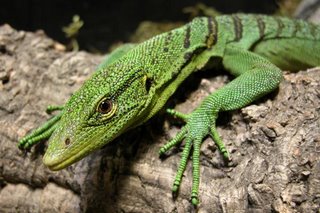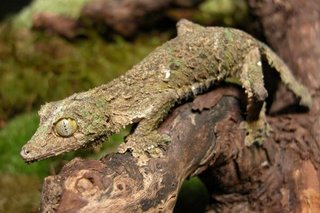 Rhacodactylus sarasinorum
Rhacodactylus sarasinorumFriday, July 28, 2006
Wednesday, July 26, 2006
Don't Eat Farmed Atlantic Tuna

The World Wildlife Federation warns that Atlantic Bluefin Tuna are nearing extinction. Much of this can be blamed on fish farms.
Bluefin tuna is near ecological and commercial extinction," said Sergi Tudela, head of the fisheries program at WWF in Barcelona, Spain.
Tuesday, July 25, 2006
Interesting but Impractical Mosquito repellent
Its been much too hot for mosquitoes lately but they should be showing up again soon as the fog rolls in and temperatures cool a bit. Just in time is an paper from Australia showing that frog secretions are great mosquito repellent, and may serve as a DEET alternative sometime in the future. Only one problem
But human tests for a frog skin-based repellent haven't been carried out, and Williams and his team already foresee‚—or foresmell‚—some obstacles to making a commercial product.
"We tried putting some of the chemicals from frog skin in a lotion," he said, "but the odor was too strong."
Some of the frogs' secretions smell of rotting meat, the team reports. Others give off aromas of nuts or thyme leaves.
The researchers say the strong smell is what repels biting insects.
Not too promising. I remember from an Organic Chemistry class a professor telling us about the active molecule in catnip, nepetalactone, being 10 times more effective in repelling mosquitoes than DEET, his only concern was it was never tested in the presence of Mt. Lions. So here in Northern California, one may just be substituting one bit for another. Again, maybe not so promising although this product is currently on the market.
UPDATE: Edited for typos
Friday, July 21, 2006
Friday Night
Watch carefully for the gecko in this video. You know this guy asked for a raise right after this segment was filmed.
What's that Nelly?
 It's still hot in here ... so besides checking temperatures on both the cool and hot sides of your cages and adjusting your heat accordingly, make sure your animals are getting enough water. Water bowls should be full, and tropical animals should get extra misting. Give your snakes, tortoises and others a good soaking this weekend. Don't be afriad to give your desert animals a descent misting during this warm weather either.
It's still hot in here ... so besides checking temperatures on both the cool and hot sides of your cages and adjusting your heat accordingly, make sure your animals are getting enough water. Water bowls should be full, and tropical animals should get extra misting. Give your snakes, tortoises and others a good soaking this weekend. Don't be afriad to give your desert animals a descent misting during this warm weather either.Now you can "take off all your clothes"
Thursday, July 20, 2006
Snakes! Good for your eyes.

A study out of the University of California, Davis reports that humans' and primates' superior close-up, color vision may have evolved in response to snakes. According to the authors "A snake is the only predator you really need to see close up. If it's a long way away it's not dangerous." I think saying "the only" is probably a bit of a stretch as it is the case of all ambush predators.
Other predators such as big cats, and hawks and eagles, evolved later. And then venomous snakes evolved about 60 million years ago, which forced primates to get better at detecting them.The idea of the lemurs is somewhat convincing, but there are non-venomous Malagasy snakes (such as the one pictured above) capable of eating smaller lemurs, at least from a size standpoint. It would be interesting to compare eyesight in the more susceptible smaller lemurs in comparison to the larger, less likely to be snake prey lemurs to see if this piece of evidence holds up.
"There's an evolutionary arms race between the predators and prey. Primates get better at spotting and avoiding snakes, so the snakes get better at concealment, or more venomous, and the primates respond," Isbell said.
And there are no dangerously venomous snakes on Madagascar, and lemurs, which only live on that large island and which have poor eyesight, have not evolved much in other ways in the past 60 million years, either, Isbell added.
Thanks to reader Xian for the link
Wednesday, July 19, 2006
Tip of the Week
Use under-tank heat pads or Pig-blankets and not bed "heating blankets" when trying to provide proper tempertures for your snake. This is only one reason (from the AP)
Other reasons include heat-blankets not being safe to use with a water bowl and their inability to precisely control temperatures.
It took surgery to save a 12-foot Burmese python after it swallowed an entire queen-size electric blanket — with the electrical cord and control box.
The blanket must have gotten tangled up in the snake's rabbit dinner, owner Karl Beznoska said. He kept the blanket in the cage to keep the 60-pound reptile, named Houdini, warm.
"Somehow, he was able to unplug the electric cord," Beznoska said Wednesday. "He at least wasn't hooked up to the power. It might have been pretty warm there."
Veterinarian Karsten Fostvedt conducted a two-hour operation on the python Tuesday, and said afterward, "The prognosis is great."
Neither Fostvedt nor fellow veterinarian Barry Rathfon had operated on a snake before. "We just basically called a couple of specialists and they told us where to go in," Fostvedt said.
X-rays showed the tangle of the blanket's wiring extending through about 8 feet of the python's digestive tract. The surgery to remove it took an 18-inch incision.
Specialists at the University of California-Davis School of Veterinary Medicine told them it probably would have taken Houdini six hours to swallow the blanket and the snake probably would have died without the operation.
Other reasons include heat-blankets not being safe to use with a water bowl and their inability to precisely control temperatures.
Global Warming Is Killing Frogs
 Ran across this study a few months back from Nature that claims Global Climate Change is responsible for massive amphibian die-offs in Central and South America.
Ran across this study a few months back from Nature that claims Global Climate Change is responsible for massive amphibian die-offs in Central and South America.The new study was led by J. Alan Pounds, the resident biologist at the Monteverde Cloud Forest Preserve in Costa Rica. In an accompanying commentary, two scientists not involved in the research say it provides "compelling evidence" that warming caused by human activity was already disrupting ecology.This fungus is a major problem in wild populations of frogs and may be what was responsible for the sudden extinction of the Golden Toad of Monteverde.
"The frogs are sending an alarm call to all concerned about the future of biodiversity and the need to protect the greatest of all open-access resources - the atmosphere," write the scientists, Andy Dobson, a Princeton University ecologist, and Andrew R. Blaustein, a zoologist at Oregon State University.
King George says "No!"

Today President Bush used his first ever veto today on a bill designed to expand Federal Funding to new stem cell lines. Keep in mind that these lines would have been created from excess embryos from in vitro fertilization clinics which will be destroyed eventually anyways. This was a bill supported by Nancy Reagan and many very conservative Republicans such as Bill Frist (TN) and Orrin Hatch (UT).
"Each and every one of us began as an embryo," said Sen. David Vitter, R-Louisiana. "Therefore, I firmly believe that [neither] Congress, independent researchers nor any human being should be allowed, in effect, to play God by determining that one life is more valuable than another."
But Sen. Orrin Hatch, R-Utah, a staunch opponent of abortion, said the bill is promotes life by encouraging research.
"I believe we are aiding the living, which is one of the most pro-life positions you can take," Hatch said.
Is our press going to ask him when he plans on banning IVF and expose his hypocrisy? I wouldn't hold my breath. The Republican War on Science continues.
UPDATE: For some good information on stem cell research see here. 66% of Americans are for embryonic stem cell research. This isn't a right vs. left issue. The American people overwhelmingly want stem cell research to go forward. The will of the people has been shot down.
Monday, July 17, 2006
It's Gettin' Hot in Here ...

Temperatures across the nation are reaching record highs as we are hit with a massive heat wave. So check your cage temperatures and adjust accordingly. Be extra diligent about making sure animals have shade in sunning pens.
Friday, July 14, 2006
Thursday, July 13, 2006
N.M. power outage blamed on snake, bird
 A power outage in New Mexico was blamed on a snake and a bird. According to the AP
A power outage in New Mexico was blamed on a snake and a bird. According to the AP "The customers lost their electricity Tuesday after a bird dropped a bull snake on a power line, shorting out the line, El Paso Electric Co. spokeswoman Teresa Souza said."Weird.
Photo is actually of a brown tree snake
Tuesday, July 11, 2006
Tuesday Gecko Blogging
"Chameleon" Snake found in Borneo Forest

A new species of poisonous snake was found in the Borneo forest by the WWF.
"I put the reddish-brown snake in a dark bucket," Mark Auliya, a German reptile expert and WWF consultant, said in a press release. "When I retrieved it a few minutes later, it was almost entirely white."
Pretty cool to see a change in color happen as a defense mechanism to go along with venom. Can't wait to hear some more information about this snake.
Friday, July 07, 2006
Science Friday
Today's Science Friday dealt with the issue of coral bleaching in our oceans. This will continue to be a major problem as our earth continues to warm. As sea water temperatures rise, the bacteria which live in corals and provide energy in a symbiotic relationship die or are purged from the corals. We aren't quite sure why yet, but do know that high temperatures are the cause. For a good run down see here.
Global Climate Change, also brings us to the upcoming hurricane season. The same warmer sea temperatures are expected to create stronger hurricanes than in years past. We had a lot of friends effected during the last hurricane season and wish them Godspeed this season.
Climate change is also leading to an increase in forest fires and more intense fires.
If you haven't seen "An Inconvenient Truth" go see it. This stuff is for real.
UPDATE: More links to Global Climate Change and forest fires here, here and here
Global Climate Change, also brings us to the upcoming hurricane season. The same warmer sea temperatures are expected to create stronger hurricanes than in years past. We had a lot of friends effected during the last hurricane season and wish them Godspeed this season.
Climate change is also leading to an increase in forest fires and more intense fires.
If you haven't seen "An Inconvenient Truth" go see it. This stuff is for real.
UPDATE: More links to Global Climate Change and forest fires here, here and here
Subscribe to:
Posts (Atom)



